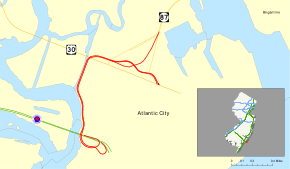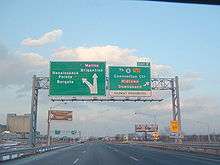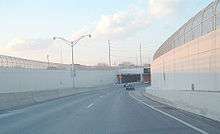Atlantic City–Brigantine Connector
| ||||
|---|---|---|---|---|
 | ||||
| Route information | ||||
| Auxiliary route of Route 446 | ||||
| Maintained by the South Jersey Transportation Authority | ||||
| Length: | 2.3 mi[1] (3.7 km) | |||
| Existed: | 2001 – present | |||
| Major junctions | ||||
| South end: |
| |||
|
| ||||
| North end: |
| |||
| Location | ||||
| Counties: | Atlantic | |||
| Highway system | ||||
| ||||
The Atlantic City–Brigantine Connector, also known as the Atlantic City Expressway Connector[2] or simply the Brigantine Connector,[3] is a highway connector in Atlantic City, New Jersey. It connects the Atlantic City Expressway with Route 87, which leads into Brigantine, a beach resort along the Atlantic Ocean. The connector is 2.5 miles (4.0 km) long and is maintained by the South Jersey Transportation Authority. It is considered to be a state highway and is assigned the route number Route 446X; however, the route number is unsigned. The connector consists of lettered exits from A to I in south to north order and features 10 bridges and 15 ramps throughout its length.
The Atlantic City–Brigantine Connector was initially planned in 1995 to provide a direct connection between the Atlantic City Expressway and the Brigantine area. Construction of the road was completed in 2001 at a total cost of $330 million (equivalent to $446 million in 2017). Before the Atlantic City–Brigantine Connector was planned, Mirage Resorts president Steve Wynn acquired a piece of land near the northern end of the proposed connector and planned for a direct exit ramp to a proposed casino called Le Jardin. Donald Trump, the chief executive officer of Trump Hotels & Casino Resorts, who owned the nearby Trump Marina (now Golden Nugget), took legal action against the state for the proposed ramp to Wynn's casino. Despite the legal concerns, construction on the connector began in 1998. Wynn's proposed casino, Le Jardin, was canceled following the acquisition of Mirage Resorts by MGM Grand Inc., which, as the MGM Mirage company, proposed the Borgata casino. Meanwhile, Trump's casino received a direct ramp from the connector.
Route description

The Atlantic City–Brigantine Connector begins near the eastern terminus of the Atlantic City Expressway on the western edge of the Atlantic City coast. The speed limit is 35 mph (56 km/h) for its entire length. The entire route of the Connector is located within the city of Atlantic City, New Jersey, and features 10 bridges and 15 ramps throughout its duration.[4] Exits are lettered based on their ramp letter designation, which range from Ramps A–I, skipping Ramp C. Ramp D east and west are two entrance-only ramps, and Ramp I is north of the Connector's terminus on Route 87. Despite its sequential lettering, Ramp H merges from the Connector prior to Ramp G. The Connector is 2.3 mi (3.7 km) long,[1] from the Atlantic City Expressway interchange to the northbound Connector's merge with Route 87 towards Brigantine, New Jersey.[3] The Atlantic City Expressway is unsigned as Route 446,[5] and the Connector has the route number 446X. According to the New Jersey Department of Transportation (NJDOT), Route 446X is 1.98 mi (3.19 km) long, measured from the Atlantic City Expressway interchange to the at-grade intersection with U.S. Route 30 via Ramp E.[6] The remainder of the Connector past Ramp E toward Route 87 is not included by NJDOT as part of the route nor calculated in its total mileage.[7]
The Connector begins from Exit 1 on the Atlantic City Expressway, and heads north along the edge of the coast. In the southbound direction, Ramp A leads towards the Downbeach and Midtown sections of the city via Mississippi Avenue, prior to merging onto the Expressway westbound. The Connector has an at-grade intersection with the Atlantic City Line, adjacent to the city's Rail Terminal. Following the railroad, Ramp B west and B south provide access to Bacharach Boulevard and the Atlantic City Convention Center in both directions on the Connector, prior to a 1,957 ft (596 m) long tunnel, which runs parallel to the Penrose Canal. Upon emerging from the tunnel, Ramp D west feeds traffic southbound on the Connector from Route 87 south, and Ramp D east feeds traffic northbound on the Connector from US 30 east. The southbound direction of the Connector begins at the Route 87 crossing, which is followed by Ramp E, a two-way ramp towards US 30 with an intersection at Route 187. The Connector continues northbound with Ramp F, which leads back to Ramp E westbound, acting as a U-turn to the Connector southbound for traffic that entered from Ramp D east. The northbound Connector then branches off with Ramp H towards Renaissance Pointe, Borgata, and The Water Club, followed by Ramp G towards Farley Marina and Golden Nugget (formerly Trump Marina) via Huron Avenue. The Connector merges onto Route 87 northbound toward Brigantine near milepost 2.3, at which Ramp I provides access to Harrah's from Route 87.[3][8][9]
History
Background

The connector road between the Atlantic City Expressway and the marina district was first proposed in 1964 by the Atlantic City Planning Board. The project was called the "Route 30 Connector" and was to connect the end of the Expressway with U.S. Route 30. The main purpose of the road was to lessen congestion in Midtown Atlantic City, and provide easier access to the uptown and marina districts, as well as the neighboring city of Brigantine, New Jersey.[10] Due to a lack of funds and environmental concerns about construction near the adjacent wetlands, the connector project remained dormant until 1990 when plans for the road were included report by the city's Transportation Executive Council.[10] Following the release of the report, engineering and planning for the road began, as well as environmental study by the New Jersey Department of Environmental Protection, to determine the project's feasibility. A transportation official, at the time, stated that if the project was approved, construction would not begin for at least four to five years.[10]
The following year, a new report was released stating that the Route 30 Connector project was feasible. The proposed Connector was to be one mile (1.3 km) long, and would be constructed as an elevated highway above the wetlands. Construction cost was estimated at $80 million, half of which could be paid for by making the Connector a toll road.[11] The new report also identified US 30 as an important roadway for reducing city traffic, as it carried the least amount of traffic and had the greatest capacity out of the city's three major entering highways, the other two being the Expressway and the Black Horse Pike (US 40/US 322).[11]
Planning and construction
In 1995, a tunnel was proposed as part of the Connector, traveling underneath Horace J. Bryant Drive; however, the idea was rejected by Mayor James Whelan and the City Council as it would have displaced many homes in the area.[12] The same year, Mirage Resorts president Steve Wynn proposed a new casino resort in the marina district, and stated that resort would not be built unless there was better access to the site.[13] Additional plans were later researched, and six different plans were proposed. The plans included the tunnel underneath Horace J. Bryant Drive, a tunnel underneath the adjacent Penrose Canal, two alternative tunnel locations, the elevated highway above the wetlands, and the improvement of existing streets to direct traffic through the city. Transportation officials determined all of the plans, except for the first two tunnel proposals, to have significant drawbacks.[14]

After the tunnel proposal was rejected, it was once again proposed in February 1996 after Wynn officially announced plans for the new resort.[15] The City of Atlantic City requested bids for the sale of the property in the northern section of the city near the marina, which at one time served as the city's landfill. Wynn won the bid against Donald Trump, chief executive officer of the Trump Organization.[16] As disputes over the tunnel construction continued, Mirage Resorts announced they were given the options of purchasing the properties required for building the tunnel. Mirage Resorts deemed building the proposed "off-island connector" as "virtually impossible", stating how permits would be difficult to obtain with a land-based alternative available, and the tunnel was determined to be the best option for construction of the Connector. The tunnel was designed to have as little impact on the surrounding environment as possible, with both portals on opposite ends of the community.[17] The design included both portals on opposite ends of the community, with landscaping added between the construction site and adjacent homes.[17] Deliveries of raw materials would take place by barge and construction vehicles would not be traveling via any local streets. Mirage subsidiary president Richard "Skip" Bronson referred to the project as "the nicest tunnel you've never seen."[17] Some opponents described the project as an effort to destroy a stable, middle-class African-American community, while others supported the project as a means of lessening traffic and creating jobs at the new Mirage casino.[18]
Wynn had intentions of constructing a new casino project on the property, known as Le Jardin, with an exit ramp from the connector leading directly to his new property.[19] The exit to Le Jardin was referred to as a "driveway" to the casino, which caused Trump to take legal action against the state, as he felt that the easy access to Wynn's new property would create an unfair business advantage against Trump Marina, a Trump-owned property in the same area.[20][21] The proposal for the grade crossing of New Jersey Transit's Atlantic City Line initially drew criticism from both the Delaware Valley Association of Rail Passengers and the Federal Railroad Administration because of the high amount of road and railroad traffic that would pass through the crossing. However, it was built because it was $24 million cheaper than building a grade-separated crossing and would allow for an interchange with Bacharach Boulevard.[22]
In 1997, Governor Christine Todd Whitman approved the project, and construction began on November 4, 1998.[23] After construction on the freeway began, Wynn's interests were purchased by MGM Grand Inc., thus creating the MGM Mirage company, and plans for Le Jardin were canceled.[24] Despite the fact that Le Jardin was canceled and MGM Mirage's new casino, Borgata, was not scheduled to open until 2003, Trump still fought against the project's plans to build the exit directly to the new casino. Eventually, in January 2000, Trump dropped his case after an exit ramp leading to the Trump Marina was added to the project.[20][25]
Very little land and property was displaced by the project. Following the construction, the land formerly housing nine residential properties displaced during construction were leveled and turned into a park. A warehouse was reduced in size to make way for the project, as well as the relocation of Atlantic City Electric power lines leading to a substation. A promenade as part of Trump Marina was leveled to make way for new ramps, in which 37 ornamental lampposts which were dismantled were later shipped to the Tuckerton Seaport in nearby Tuckerton, which opened in 2000.[26]
Opening
On July 27, 2001, the Atlantic City–Brigantine Connector was completed after a 32-month construction period. The grand opening ceremony was open to the public, which featured various festivities, including a pedestrian tunnel walk.[20] However, the connector was not opened to traffic until four days later due to a last-minute failure of the tunnel communications system.[4][20] Although the connector itself was open to traffic, the exit ramps leading to the Borgata were still under construction along with the resort itself, and the ramps did not open up until October 2003.[23] The total cost of the project was $330 million (equivalent to $446 million in 2017)[27] and was funded by various state-operated agencies, while one-third of the cost was privately funded by MGM Mirage.[20]
Exit list
The entire route is in Atlantic City, Atlantic County.
| mi[9] | km | Exit | Destinations | Notes | |
|---|---|---|---|---|---|
| 0.00 | 0.00 | – | |||
| 0.31 | 0.50 | A | Midtown, Downbeach | Southbound exit and northbound entrance | |
| 0.55 | 0.89 | B | Bacharach Boulevard – Convention Center | ||
| 0.88– 1.24 | 1.42– 2.00 | Tunnel under Horace J. Bryant Drive | |||
| 1.48 | 2.38 | E | Northbound exit and southbound entrance; southbound roadway begins here | ||
| 1.66 | 2.67 | F | Northbound exit only; u-turn ramp to southbound lane | ||
| 1.77 | 2.85 | H | Renaissance Pointe, Borgata, The Water Club | Northbound exit only | |
| 1.83 | 2.95 | G | Farley Marina, Golden Nugget | Northbound exit only | |
| 2.30 | 3.70 | – | Northbound roadway terminates here | ||
1.000 mi = 1.609 km; 1.000 km = 0.621 mi
| |||||
See also
 U.S. Roads portal
U.S. Roads portal New Jersey portal
New Jersey portal
References
- 1 2 "Atlantic City Expressway: History & Milestones". South Jersey Transportation Authority. Retrieved July 4, 2009.
- ↑ Glassey, Stanley R. & Crawford, James A. (2001). 2001 Annual Report (PDF) (Report). South Jersey Transportation Authority. pp. 6–7. Retrieved March 17, 2010.
- 1 2 3 Map of the Connector (Map). South Jersey Transportation Authority. Retrieved February 9, 2009.
- 1 2 "Travel Advisory; Marina District Tunnel Is Open in Atlantic City". The New York Times. August 26, 2001. Retrieved April 5, 2009.
- ↑ Kiniry, Laura (2009). New Jersey. Moon Handbooks (2nd ed.). Perseus Books Group. p. 356. ISBN 978-1-59880-156-9. Retrieved July 5, 2010.
- ↑ Atlantic City-Brigantine Connector (South to North) (PDF) (Map) (2009 ed.). New Jersey Straight Line Diagrams. New Jersey Department of Transportation. April 2009. Retrieved June 29, 2009.
- ↑ Atlantic City-Brigantine Connector at US 30 (PDF) (Map) (2009 ed.). New Jersey Straight Line Diagrams. New Jersey Department of Transportation. 2009. Retrieved July 4, 2009.
- ↑ "Atlantic City–Brigantine Connector Mile Post and Ramp Designation" (PDF). South Jersey Transportation Authority. 2001. Archived from the original (PDF) on April 29, 2004. Retrieved April 13, 2016.
- 1 2 "Atlantic City–Brigantine Connector Grand Opening July 27, 2001" (PDF) (Press release). South Jersey Transportation Authority. July 19, 2001. Archived from the original (PDF) on July 15, 2004. Retrieved April 13, 2016.
- 1 2 3 Wittkowski, Donald (October 13, 1990). "Expressway, Rte. 30 Link Resurrected". The Press of Atlantic City. p. B1.
- 1 2 Wittkowski, Donald (June 14, 1991). "Traffic Plan Says Route 30 Link Will Ease Atlantic City Traffic". The Press of Atlantic City. p. C1.
- ↑ Peele, Thomas & Wittkowski, Donald (November 30, 1995). "A.C. Rejects Plan for Tunnel Connecting Expressway, Casino Site". The Press of Atlantic City. p. A1.
- ↑ Wittkowski, Donald (December 9, 1995). "Link Between Expressway and Route 30 Proposed". The Press of Atlantic City. p. A1.
- ↑ "The Mirage Casino Tunnel Controversy". The Press of Atlantic City. February 21, 1996. p. A5.
- ↑ DeAngelis, Martin (February 2, 1996). "Creativity, Cooperation, Construction". The Press of Atlantic City. p. C1.
- ↑ Pulley, Brett (January 27, 1996). "Battle Brews in Atlantic City". The New York Times. Retrieved April 5, 2009.
- 1 2 3 Heneghan, Daniel (February 10, 1996). "Mirage: Options Bought on Most Tunnel Homes". The Press of Atlantic City. p. D5.
- ↑ Wittkowski, Donald & Peele, Thomas (February 21, 1996). "The Mirage Casino Tunnel Controversy". The Press of Atlantic City. p. A1.
- ↑ Halbfinger, David M. (March 8, 2000). "Opinion Split on Whitman's Atlantic City Efforts in View of Casino Sale". The New York Times. Retrieved April 5, 2009.
- 1 2 3 4 5 Patterson, Iver (July 28, 2001). "Atlantic City Car Tunnel Opens Briefly, for Pedestrians". The New York Times. Retrieved December 30, 2007.
- ↑ "Metro Business; Trump Wins Ruling On Tunnel Project". The New York Times. January 26, 2000. Retrieved December 30, 2007.
- ↑ "Atlantic City–Brigantine Connector". Delaware Valley Association of Rail Passengers. Retrieved April 8, 2009.
- 1 2 "Atlantic City Expressway History and Milestones". South Jersey Transportation Authority. Retrieved December 30, 2007.
- ↑ "Casino Tunnel May Not Be Ready by July 4, Contractor Says". Las Vegas Review-Journal. Associated Press. February 21, 2001. Retrieved April 5, 2009.
- ↑ Rosenberg, Amy S. (July 28, 2001). "Atlantic City Tunnel Carries Human Cost". The Philadelphia Inquirer. Retrieved December 30, 2007.
- ↑ Volpe, Gregory J. (January 20, 2000). "A Bit of A.C. Night Life Comes to Tuckerton Seaport". The Press of Atlantic City. Retrieved June 13, 2011. (Subscription required (help)).
- ↑ Federal Reserve Bank of Minneapolis Community Development Project. "Consumer Price Index (estimate) 1800–". Federal Reserve Bank of Minneapolis. Retrieved January 2, 2017.
External links
| Wikimedia Commons has media related to Atlantic City-Brigantine Connector. |
